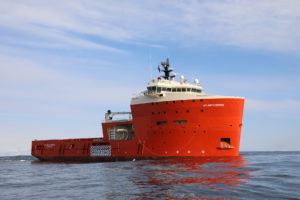
Watch: Supply vessel to use Vard Electro’s hybrid battery technology

Atlantic Towing has announced it is integrating Vard Electro’s hybrid battery technology on its platform supply vessel, Atlantic Shrike. It is the first company to implement this multiple mode application of battery technologies on a single vessel in the Canadian offshore oil and gas industry.
Atlantic Towing has received funding for the project through Petroleum Research Newfoundland & Labrador (PRNL) as a component of the offshore research, development and demonstration program of Natural Resources Canada’s (NRCan) Emissions Reduction Fund (ERF). The funding will support upgrades to Atlantic Shrike – one of four modern diesel-electric builds – and allow the integration of battery systems into the vessel’s existing diesel-electric propulsion plant.
Supporting Atlantic Towing’s goal of reducing its carbon footprint, Vard Electro will deliver a containerised energy storage system for hybrid battery power. The company says its SeaQ Energy Storage System (ESS) will decrease fuel consumption and carbon emissions while reducing the vessel’s maintenance requirement without compromising operational performance.
The SeaQ ESS stores excess energy available in the vessel to use later, reducing fuel consumption and optimising performance of the vessel. It facilitates for operations with fewer engines online, with the online engines operating at a more optimal load. The company says safety is also increased by the batteries’ ability to supply immediate energy in critical situations.
“We share the ambitions of Atlantic Towing and are looking forward to implement the products and integrated solutions that will lead to a greener industry,” says Peter Pilskog, vice president sales & business development, Vard Electro. “The innovative design and extended battery size offer a range of benefits and will be a perfect fit for the operational profile of this vessel.”
Control and monitoring of the hybrid system is handled by the energy management system (EMS) that communicates with the existing control systems onboard. By using the batteries to absorb and dispense energy through load fluctuations and running the engines at optimal load, it’s said that significant efficiency improvements in fuel consumption and emission reduction can be achieved.
Vard Electro says the demand for hybrid battery systems is steadily increasing. In the SeaQ ESS, 99 per cent of the battery weight can be recycled, and when a lithium-ion battery has served its intended use and lifetime onboard, the remaining capacity will be used for other purposes in other industries.
